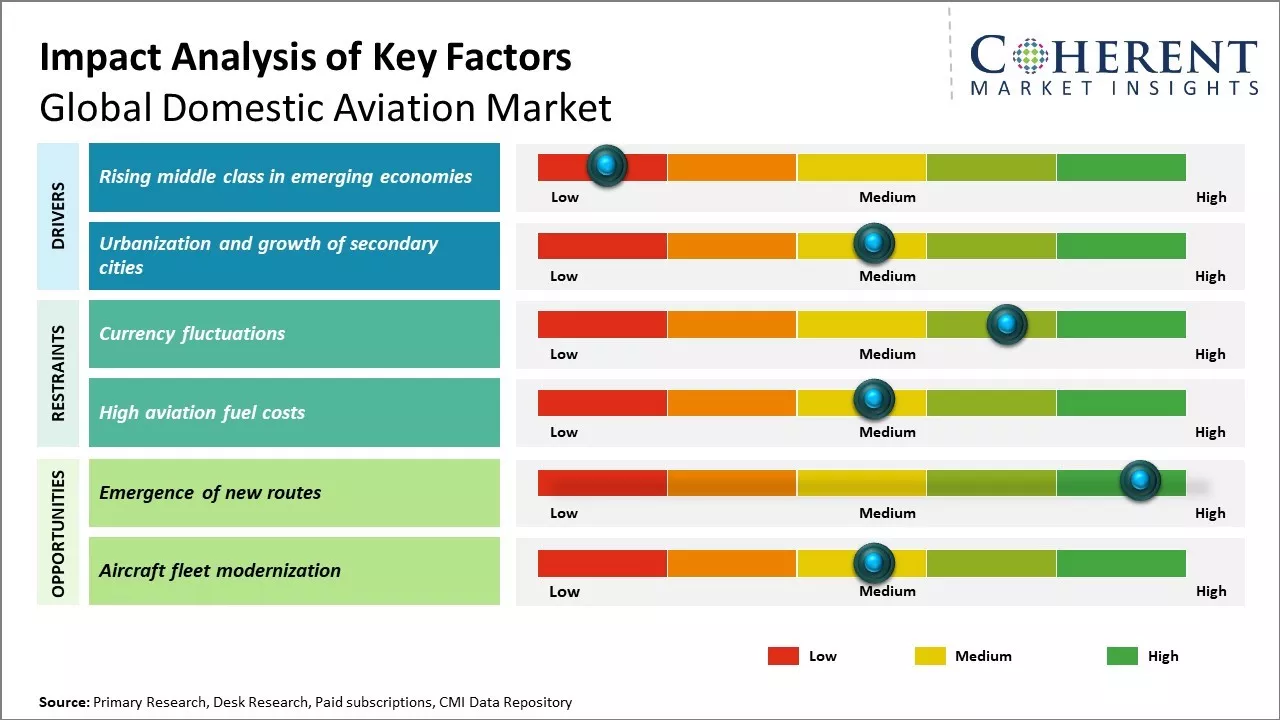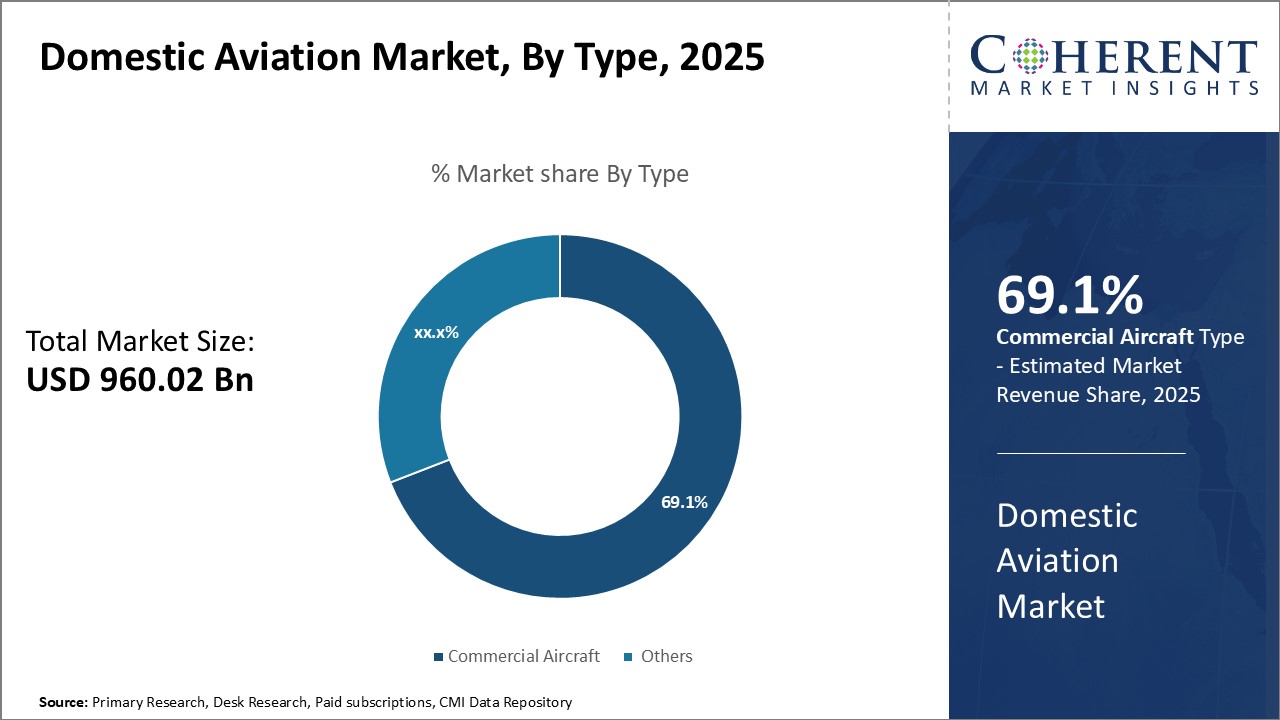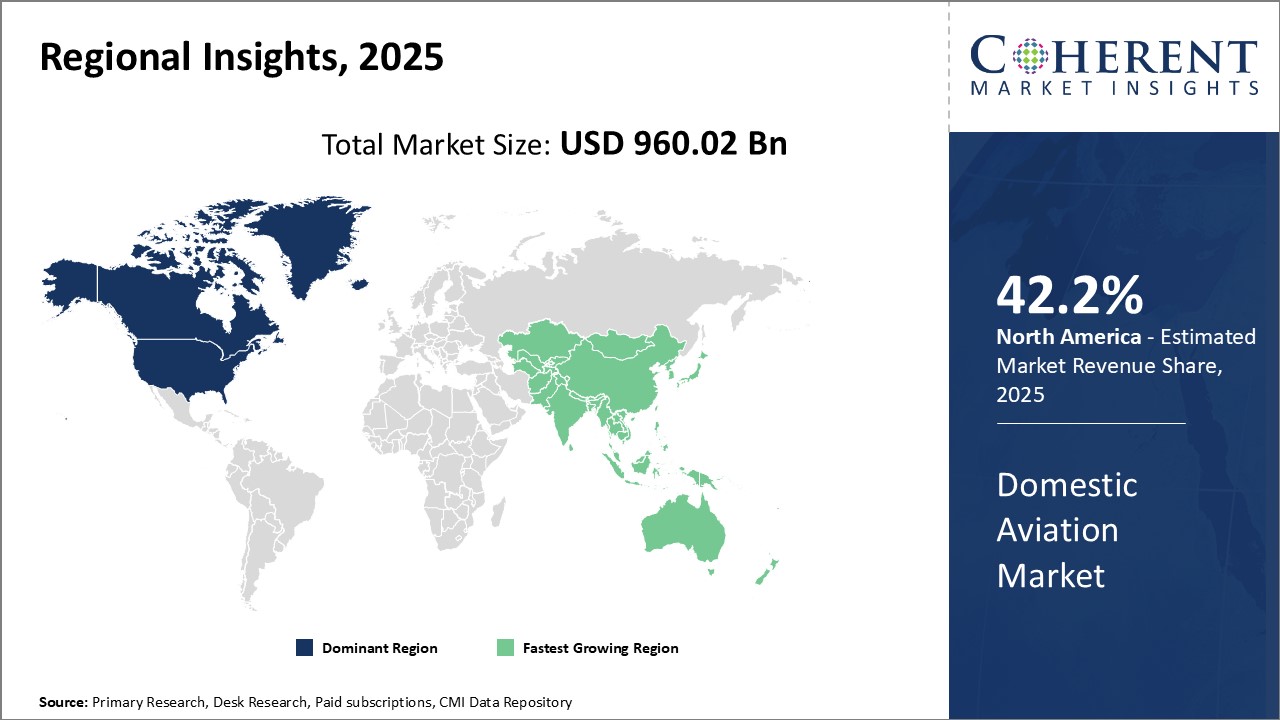The Global Domestic Aviation Market is estimated to be valued at US$ 960.02 Bn in 2025 and is expected to reach US$ 1,272.70 Bn by 2032, exhibiting a compound annual growth rate (CAGR) of 4.1% from 2025 to 2032.

Discover market dynamics shaping the industry: Request sample copy
The growth of the domestic air travel will be driven by increasing disposable income, expansion of middle-class population, and growing urbanization in emerging economies across Asia and Africa. Lower pricing enabled by no-frills carriers has made air travel much more affordable for the masses. This augurs well for passenger traffic growth expectations. While factors like economic uncertainties, high oil prices and geopolitical issues may pose challenges, overall, more liberal aviation policies coupled with developing airport infrastructure across many countries are likely to boost connectivity and intra-regional air travel volumes over the long run. The growing preference for fast, affordable and convenient air travel is projected to support the industry's upward trajectory over the forecast period.
Rising middle class in emerging economies
The growth of the middle-class population in emerging economies across Asia, Africa, and Latin America has boosted domestic air travel demand in recent years. Countries such as India, Indonesia, Brazil have witnessed strong economic growth over the past decade which has lifted millions out of poverty and into the middle-income groups. These individuals now have greater disposable incomes to spend on goods and services that were beyond their reach earlier. Domestic air travel is one such service that has become accessible to more people in these nations.
The burgeoning middle class in large emerging countries see aviation as an aspirational mode of transport. They now prefer short haul flights within their domestic borders to save travel time as compared to road or rail journeys. This is evident from the traffic numbers of low-cost carriers that have proliferated within these markets. They offer affordable fares targeted at price-sensitive customers. The appeal of air travel comes from both - its convenience and ability to flaunt economic prosperity. Consumer trends indicate people allocate more share of their budgets to experiences and leisure activities as living standards improve. Domestic flights enable them to visit family across states or spend weekends in popular tourist destinations within their own large and diverse countries.

Get actionable strategies to beat competition: Request sample copy
Urbanization and growth of secondary cities
Rapid urbanization has been a major driver for the growth of the domestic aviation sector globally. Over the past few decades, large numbers of people have migrated from rural areas to cities in search of better livelihood opportunities and amenities offered in urban centers. As a result, more than half the world's population now resides in cities, and this urban population continues to swell rapidly. Many nations have also actively promoted policies to encourage urban development beyond primary metropolitan regions, in order to decongest major cities and promote balanced regional growth. This has led to the emergence and rise of several new secondary cities and smaller towns, particularly in developing nations.
The rise of secondary cities has created new market opportunities for airlines to expand their domestic route networks and tap into previously underserved travel demand. Point-to-point air travel between these emerging urban centers and larger cities has surged, as passengers opt for the convenience and speed of flying over lengthy surface transport journeys. Airlines have rapidly launched new routes to capitalize on this fresh market potential.
Investments to develop and modernize airports in secondary cities aim to provide efficient air connectivity to drive their economic growth and integration with national and global markets. Improved air access is seen as a key enabler to attract investment, create jobs and boost tourism in these fast-growing urban regions.
Key Takeaways from Analyst:
Low-cost carriers have significantly driven demand by offering affordable ticket prices, especially in developing markets. Further, ticket price wars among carriers will boost passenger volumes.
However, high jet fuel costs remain a major challenge as oil prices remain volatile globally. Escalating fuel costs can significantly reduce the margins of carriers. Air traffic congestion at major airports also acts as a restraint and causes flight delays if not addressed properly. Nevertheless, newer airport infrastructure developments and expansion of existing airports will help alleviate some of these issues.
The Asia Pacific region, led by strong growth in India and China, will likely remain the fastest expanding domestic market worldwide. North American and European carriers are aggressively focusing on non-stop intra-regional connectivity to tap opportunities. Low cost and hybrid carriers also see excellent potential in underserved African and Latin American domestic routes.
Overall, the favourable economic environment, increasing urbanization and airline industry consolidation should propel global demand over the next decade. While downside risks remain, most industry participants are optimistic about the long-term outlook if oil prices remain stable. Regional connectivity and new aircraft deliveries are areas analysts will be closely watching.
Market Challenges: Currency fluctuations
Currency fluctuations have significantly restrained the growth of the global domestic aviation market in recent years. The volatility in currency exchange rates introduces additional risks and uncertainties for airlines as well as passengers. For airlines, fuel costs which constitute a major portion of operating expenses are globally priced in US dollars. When the domestic currency depreciates against the US dollar, it leads to higher fuel costs for airlines. This eats into the margins of airlines and forces them to either cut down operations or increase fares. Both of these actions negatively impact the demand for air travel.
Market Opportunities: Emergence of new routes
The emergence of new routes presents a significant opportunity for growth in the global domestic aviation market. As economies continue to develop across regions and populations become increasingly mobile, demand for connectivity within and between countries will only increase.
One of the ways this demand can be met is through the establishment of new domestic air routes. Opening direct flights between cities that previously had poor or no air linkages can open up enormous economic benefits. It allows for easier movement of people whether for work, education or tourism. Industries become less constrained by limitations of transport infrastructure. New routes also facilitate the expansion of regional supply chains and clustering of industries.

Discover high revenue pocket segments and roadmap to it: Request sample copy
Insights By Type, Commercial Aircraft contributes the highest share of the market owing to increasing air passenger traffic
By type, the commercial aircraft segment is estimated to dominate the global domestic aviation market with 69.1% share in 2025 due to the growing demand for air travel within countries. The rise of the middle class in developing nations, with increased disposable incomes, has driven greater demand for domestic air travel for both business and leisure purposes. Governments have implemented initiatives to promote domestic tourism, further stimulating this demand. In response, airlines have expanded their commercial aircraft fleets to accommodate the growing passenger traffic. New, more fuel-efficient aircraft models with enhanced passenger experience are being delivered by leading manufacturers, enabling carriers to reduce operating costs and attract more customers.
Investments in air travel infrastructure, such as airports and flight routes, have improved connectivity within large countries, facilitating commerce and people movement. The commercial aviation segment is expected to remain the primary growth driver going forward. As urbanization intensifies and digital connectivity brings distant locations closer, intra-country flight frequency and passenger volumes will continue rising. The proliferation of low-cost airlines has also made air travel more affordable for the masses.
Sustained economic development in emerging markets is poised to further augment the dominance of the commercial aircraft segment in the global domestic aviation industry for years to come.
Insights By Application, Commercial contributes the highest share of the market driven by business and leisure travel demand
The commercial application is estimated to occupy 46% share for 2025 in the global domestic aviation market owing to strong demand from business and leisure travelers. Many countries have sizable consumer bases that are increasingly engaging in domestic trips for work or relaxation purposes.
The pandemic has redirected more transportation spending towards domestic tourism, boosting the popularity of various regional destinations within countries. Domestic business activities have also remained resilient overall, necessitating continued business flights between cities.
In response, carriers catering to the commercial segment have adapted by launching new point-to-point regional routes. These provide fast, convenient air options compared to longer surface journeys, allowing carriers to capitalize on this demand. Inter- and intra-city flight networks have grown denser to efficiently serve business hubs and tourist hotspots.
Furthermore, online travel agencies promote affordable commercial airfares year-round through user-friendly booking platforms. This drives significant leisure demand, especially among younger, digitally native consumers.
As domestic consumption patterns continue evolving with growing national economies, the commercial aviation segment will likely sustain its predominance going forward. Both companies and individuals will continue relying heavily on commercial aviation services for their domestic transportation needs.

Need a Different Region or Segment? Customize now
North America has established itself as the dominant region in the global domestic aviation market and is estimated to account for 42.2% share in 2025. The large geographical presence of the U.S. has enabled major airline carriers like American Airlines, Delta, and United to establish an extensive domestic network within the country and across borders into Canada and Mexico. This network allows these carriers to transport both business and leisure passengers within the region, gaining significant market share. Additionally, the presence of major aircraft manufacturers like Boeing provides local carriers an advantage in terms of pricing and availability for aircraft spare parts supports. With major hubs located in large cities like New York, Chicago, Atlanta and Los Angeles, these airlines have been able to leverage economies of scale to lower operational costs. This cost competitiveness has helped them maintain their leadership position.
The Asia Pacific region has emerged as the fastest growing domestic aviation market globally. Rapid economic growth and rising incomes in countries like China, India and Indonesia has boosted demand for air travel significantly. China, in particular has seen tremendous growth in the number of airports as well as new airlines operating in the domestic segment. Carriers like China Southern, China Eastern have massively expanded their fleet sizes and route networks. This growth presents lucrative opportunities for aircraft manufacturers and other aviation component companies to tap into. The region also benefits from relatively lower fuel prices which is a major cost component.
As urbanization increases and more tier-2 and tier-3 cities become economically important, the need for air connectivity within countries is driving growth. Low-cost carriers have also entered domestic markets of countries like India and Indonesia, making air travel affordable for masses. This in turn is sustaining the high growth momentum. While infrastructure constraints remain challenges, the market potential on account of large population and growing middle class is making Asia-Pacific one of the most dynamic aviation regions globally.
Domestic Aviation Market Report Coverage
| Report Coverage | Details | ||
|---|---|---|---|
| Base Year: | 2024 | Market Size in 2025: | USD 960.02 Bn |
| Historical Data for: | 2020 To 2024 | Forecast Period: | 2025 To 2032 |
| Forecast Period 2025 to 2032 CAGR: | 4.1% | 2032 Value Projection: | USD 1,272.70 Bn |
| Geographies covered: |
|
||
| Segments covered: |
|
||
| Companies covered: |
Air New Zealand, All Nippon Airways, American Airlines, Airbus SE, Embraer S.A., Emirates, EVA Air, IndiGo, Lockheed Martin Corporation, Qantas, Qatar Airways, Singapore Airlines, SpiceJet, Textron Inc., and The Boeing Company |
||
| Growth Drivers: |
|
||
| Restraints & Challenges: |
|
||
Uncover macros and micros vetted on 75+ parameters: Get instant access to report
*Definition: The global domestic aviation market consists of air passenger and cargo transportation services operated within the territorial boundaries of a country. It includes both scheduled and non-scheduled air travel between destinations within the same country. Major players in this market operate domestic flight networks to connect various domestic cities, towns and regions within a country. The size and growth of individual country's domestic aviation market depends on factors like the country's geographic size, population, economic growth and demand for domestic air travel.
Share
Share
About Author
Suraj Bhanudas Jagtap is a seasoned Senior Management Consultant with over 7 years of experience. He has served Fortune 500 companies and startups, helping clients with cross broader expansion and market entry access strategies. He has played significant role in offering strategic viewpoints and actionable insights for various client’s projects including demand analysis, and competitive analysis, identifying right channel partner among others.
Missing comfort of reading report in your local language? Find your preferred language :
Transform your Strategy with Exclusive Trending Reports :
Frequently Asked Questions
Joining thousands of companies around the world committed to making the Excellent Business Solutions.
View All Our Clients
US Reciprocal Tax Impact Analysis On Domestic Aviation Market
Stay updated on tariff changes with expert insights and timely information